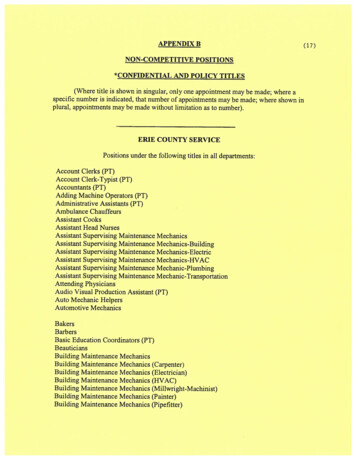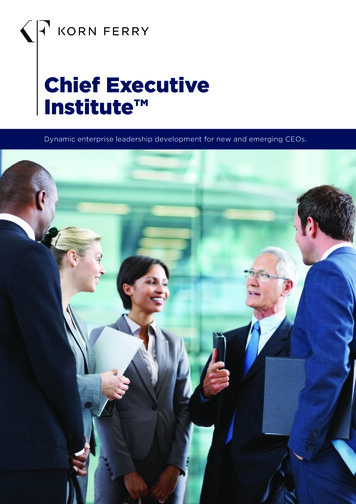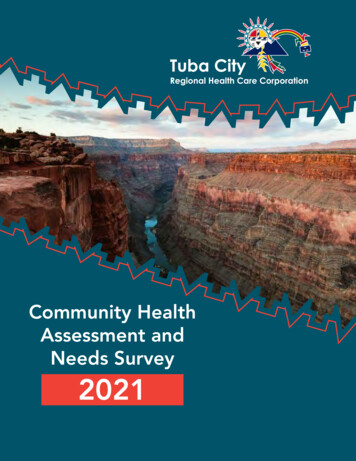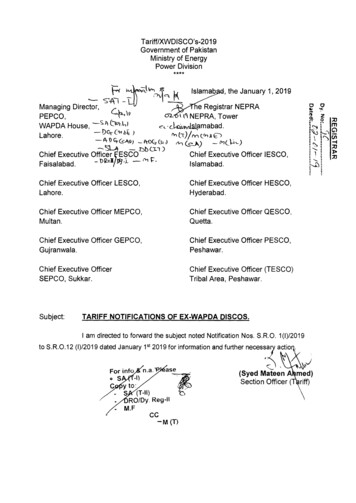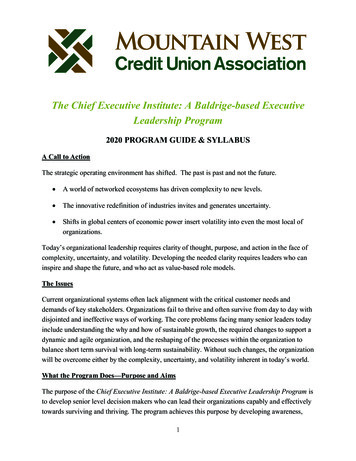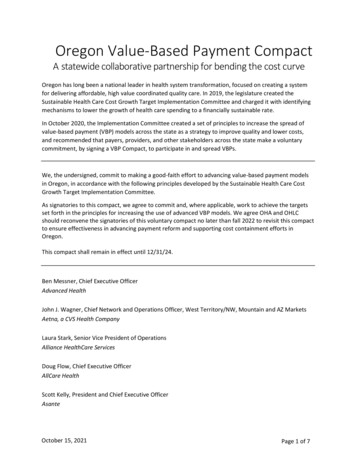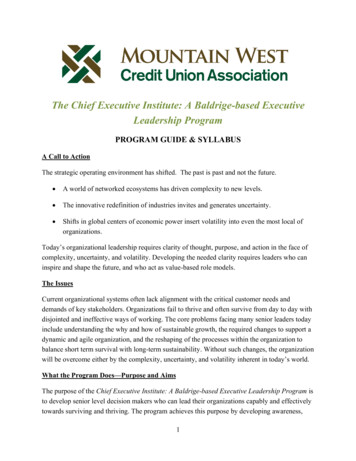
Transcription
The Chief Executive Institute: A Baldrige-based ExecutiveLeadership ProgramPROGRAM GUIDE & SYLLABUSA Call to ActionThe strategic operating environment has shifted. The past is past and not the future. A world of networked ecosystems has driven complexity to new levels. The innovative redefinition of industries invites and generates uncertainty. Shifts in global centers of economic power insert volatility into even the most local oforganizations.Today’s organizational leadership requires clarity of thought, purpose, and action in the face ofcomplexity, uncertainty, and volatility. Developing the needed clarity requires leaders who caninspire and shape the future, and who act as value-based role models.The IssuesCurrent organizational systems often lack alignment with the critical customer needs anddemands of key stakeholders. Organizations fail to thrive and often survive from day to day withdisjointed and ineffective ways of working. The core problems facing many senior leaders todayinclude understanding the why and how of sustainable growth, the required changes to support adynamic and agile organization, and the reshaping of the processes within the organization tobalance short term survival with long-term sustainability. Without such changes, the organizationwill be overcome either by the complexity, uncertainty, and volatility inherent in today’s world.What the Program Does—Purpose and AimsThe purpose of the Chief Executive Institute: A Baldrige-based Executive Leadership Program isto develop senior level decision makers who can lead their organizations capably and effectivelytowards surviving and thriving. The program achieves this purpose by developing awareness,1
understanding, and workplace application of the Baldrige Excellence Framework and the varioustools and techniques used to help organizations obtain excellence. The program is specificallydesigned for new and emerging CEOs and other senior organizational leaders who want topromote quality, continuous improvement, and excellence towards achieving the mission, vision,and values of the participant’s organizations.The aims of the Chief Executive Institute: A Baldrige-based Executive Leadership Program areto:1. Teach, use, and learn how to apply the Baldrige Excellence Framework and the varioustools of excellence for organizational decision-making and problem solving.2. Recognize the challenge of change and the consequences of change while operating as astrategic leader within a volatile, uncertain, complex, and ambiguous (VUCA)environment.3. Cultivate values-based strategic leaders who exemplify the highest standards of ethicsand morale character.4. Broaden the perspectives and frame of references of the participants beyond theirrespective organizations and industries for cross-sector and cross-profession learning, andthen leverage this knowledge for organizational improvement.ParticipantsThe recommended participants for the seminar series include new and emerging CEOs (andequivalents). By new CEOs, we recommend senior leaders with five years or less experience inthe position. By emerging CEOs, we recommend senior leaders who most likely will becomeCEOs within the next 5 years. Each participant group is limited to 20 individuals.Why Baldrige?The Baldrige Framework is a holistic approach to understanding, defining, managing,synchronizing, and leading the totality of the organization to include instituting key metrics andmeasures designed to ensure continuous improvement towards goal achievement. Through selfstudy, evaluation, change management, and leadership, the organization transforms into adynamic, customer-centric structure with greater clarity of focus on core values, mission, andvision.As discussed on the Baldrige website (http://www.nist.gov/baldrige/):2
Baldrige is about seeing more clearly where your organization is now and where youneed to be to achieve long-term success. Baldrige is about having the tools to examine and improve each dimension of yourorganization’s performance while keeping the whole organization in mind. Baldrige is about an organization-wide perspective that optimizes an entire system ratherthan just focusing on pockets of excellence.Thousands of organizations use the Baldrige Excellence Framework and its Criteria forPerformance Excellence to guide their enterprises, improve performance, and get enduringresults. This proven improvement and innovation framework offers organizations an integratedapproach to key management areas: Leadership, Strategy, Customers, Measurement, Analysis,Knowledge management, Workforce, Operations, and Results. The Baldrige ExcellenceFramework helps evaluate performance, assess where improvements or innovation are mostneeded, and get results. Baldrige offers a proven way to achieve innovation, world-class results,integrated processes that enhance your effectiveness and efficiency, organizational learning, andlong-term success.The Baldrige FrameworkThe guiding principle used to define, shape, and conduct the program is the Baldrige ExcellenceFramework as depicted within the following figure.3
Program IntegrationDuring the five seminars, we will introduce, discuss, and demonstrate application of several toolsdesigned specifically to help senior leaders understand their organization and obtain measurableresults. Participants will receive a copy of The Senior Leader Toolbox, which describes severaltools of organizational transformation including: Baldrige Excellence Framework The 5 Disciplines of Highly Effective Organizations The Business Model Canvas Appreciative Strategy using SOAR Organizational Coaching Business process design Succession Planning Quality management systems Business Process ImprovementThe Senior Leader Toolbox: Baldrige-based Quality Enhancement Tools forSenior Leaders is published by Peregrine Pathways(www.PeregrinePathways.com). This booklet summarizes 66 distinct toolsrelated to quality enhancement. The tools are organized based on the sevenBaldrige categories and will be used throughout the program as the workbookfor the CEI.The other primary reference book for Chief Executive Institute: A Baldrigebased Executive Leadership Program is Peregrine’s Leading Organizations:Innovating for Performance Excellence, which is also published by PeregrinePathways and available on Amazon. Participants will be provided with a copyof this book. The book includes background materials, case studies, examples,tool use details, and other relevant reference materials that will be discussedthroughout the program.4
Learning OutcomesGrounded in the Baldrige Excellence Framework, the specific learning outcomes for the programare as follows:1. Leadership. At the conclusion of the program, participants will be able to:a. Understand and exemplify the essential leadership values of integrity, respect,service before self, honesty, accountability, trust, and loyalty.b. Demonstrate the core senior leadership skills including interpersonal skills(communicating, using dialogue, negotiating, achieving consensus, and buildingstaffs), conceptual skills (envision, developing frames of reference, and dealingwith uncertainty and ambiguity), and technical skills (the strategic art, leveragingtechnology, and translating goals into objectives).c. Confidently perform the core senior leader actions including influencing actions(communicating, decision-making, and motivating), operating actions (strategicplanning, executing, and strategic assessment), and improving actions(developing, building, and learning).d. Exemplify a transformation leadership style.e. Understand how leadership is a system within the larger framework of theorganization.2. Strategy & Customers. At the conclusion of the program, participants will be able to:a. Describe and discuss the strategy development process to includei. Strategic planning process.ii. Innovation and change.iii. Strategy Considerations.iv. Work Systems and core Competencies.b. Form and assess Strategic Objectives to includei. Key strategic objectives.ii. Strategic objective considerations.5
3. Customer Focus. At the conclusion of the program, participants will be able to:a. Conduct customer listening including both current and potential customers.b. Determine customer satisfaction and engagement including satisfaction,dissatisfaction, and engagement; satisfaction relative to competitors.4. Measurement, Analysis, and Knowledge Management. At the conclusion of theprogram, participants will be able to:a. Use measurement, analysis, and improvement of organizational performanceincluding:i. Conduct performance measurement to include performance measures,comparative data, customer data, and measurement agility.ii. Conduct performance analysis and review.iii. Conduct performance improvement to include best practices, futureperformance, and continuous improvement and innovation.b. Use knowledge management, information, and information technology(organizational knowledge management and learning and data information andinformation technology).5. Workforce Focus. At the conclusion of the program, participants will be able to:a. Assess the workforce environment (capability and capacity, new workforcemembers, work accomplishment, and workforce change management).b. Evaluate the workforce climate (workplace environment and workforce benefitsand policies).c. Perform Workforce engagement (organizational culture, drivers of engagement,assessment of engagement, and performance management).d. Facilitate workforce and leader development (succession planning, learning anddevelopment systems, learning and development effectiveness, and careerprogression).6. Operations Focus. At the conclusion of the program, participants will be able to:a. Conduct work process review (product and process design, process management,innovation management).6
b. Evaluate operational effectiveness (process efficiency and effectiveness, supplychain management, and safety and emergency preparedness).7. Results. At the conclusion of the program, participants will be able to:a. Develop and assess product and process results (customer-focused product andservices results, work process effectiveness results, and supply-chain managementresults).b. Develop and assess customer-focused results (customer satisfaction and customerengagement).c. Develop and assess workforce-focused results (capability, capacity, climate,engagement, and development).d. Develop and assess leadership and governance results (leadership, governance,law and regulation, ethics, and society).e. Develop and assess financial and market results (financial performance andmarketplace performance).8. Change. At the conclusion of the program, participants will be able to:a. Conduct a strategic assessment and organizational profile related to the operatingenvironment, relationships, and strategic situation.b. Understand the elements of change management and change leadership.c. Respond effectively and efficiently to change.AssessmentProgram assessment will be conducted using the following approaches:1. Pre-program 360 degree assessment. A survey of the participants will identify specificproblem areas that the participants face so that these problems can be integrated into thesubsequent sessions.2. Baldrige Insights Survey. An organizational survey designed to identify organizationalstrengths and opportunities for improvement related to the Baldrige PerformanceExcellence categories.3. Complete the Personality Structure Analysis (PSA). This online instrument is used toidentify personal strengths and weaknesses relative to leadership and will be provided by7
our partner, the Life and Career Design located in Vienna, Austria(http://lifeandcareer.eu/en/).4. Session Evaluations. At the conclusion of each session, participants will complete awritten session evaluation to identify the strengths and weaknesses of the specificsession.5. Post-program survey. At the end of the program, participants will complete a surveyregarding the program’s learning outcomes and problem-solving sessions.The Action Learning, Problem-based ConstructThe basic method used for the Chief Executive Institute: A Baldrige-based Executive LeadershipProgram is experiential learning, whereby participants learn from each other, the sessionmentors, and from other outside sources that are leveraged throughout the program.Case Studies will be used to facilitate the problem-solving process. The case studies includeactual Baldrige submissions that are edited to introduce specific problems that the participantswill address during the small-group exercises.Additional action-learning is obtained using case studies specific to the seminar topics. Duringeach seminar, participants will discuss results and explore how the results can be applied to theparticipant’s organization.Program AgendaThere are five sessions to the program with three one-on-one coaching/mentoring sessions forthe participants planned between the group sessions. Each session is two days in duration with anetworking dinner in the evening. Sessions are conducted approximately two months apart.Sessions and themes (mapped to the Learning Outcomes) are as follows.Pre-Session #1: Complete a Senior Leader 360-degree Assessment. The results of thisevaluation will be discussed during the first session and reviewed one-on-one following thefirst session.1. Session #1 - Strategic Leadership. (Learning Outcome # 1). Participants will be assigned asenior leader mentor who will assist the participant throughout the program between thesessions with completion of the requirements.Post Session #1: Administration of the Baldrige Insights Questionnaire and Diagnostic. Theparticipant will be assisted by the assigned mentor.8
2. Session #2 – Strategic Planning and Customer Focus (Learning Outcomes #2 and #3).Post Session #2: Initial Draft of the Participant’s Organization’s Business Model Canvas. Theparticipant will be assisted by the assigned mentor.3. Session #3 – Measurement, Analysis, and Knowledge Management (Learning Outcome #4)Post Session #3: Complete relevant sections of the Participant’s Business Model Canvas.Prepare draft of the project plan using the appropriate planning tools.4. Session #4 – Workforce Focus (Learning Outcome #5)Post Session #4: Finalize the Participant’s Business Model Canvas. Finalize the project plan.Prepare presentation that will be given in Session #5 (about 30 minutes/participant). Thispresentation will highlight the organization’s Business Model Canvas and the Project Plan toaddress any gaps found with Business Model Canvas.5. Session #5 – Operations Focus (Learning Outcomes #6)Learning Outcomes #7 (Results) and #8 (Change) will be included throughout all sessions duringthe team-based problem-solving sessions.9
SessionDatesTopicsFebruary1MarchStrategic Leadership(Learning Outcome #1)March / April2MayStrategic Planning &Customer Focus(Learning Outcomes #2and #3).May / June3JulyMeasurement, Analysis,and KnowledgeManagement(Learning Outcome #4)July / August4SeptemberSeptember /OctoberWorkforce Focus(Learning Outcome #5)Mentoring Support ActivitiesComplete the Senior Leader 360-degree Assessment.The results of this evaluation will be discussed during the first session andreviewed one-on-one following the first sessionSenior Leader MentoringParticipants will be assigned a senior leader mentor who will assist theparticipant throughout the program between the sessions with completion ofthe requirementsBaldrige Insights Questionnaire and Diagnostic.The participant will be assisted by the assigned mentorDebrief of Baldrige Insights Questionnaire during sessionsInitial Draft of the Participant’s Organization’s Business Model Canvas.The participants will be assisted by the assigned mentorDebrief and sharing of Business Model Canvas during sessionComplete relevant sections of the Participant’s Business Model Canvas.Prepare draft of the project plan using the appropriate planning toolsDebrief and sharing of updated Business Model Canvas during sessionFinalize the Participant’s Business Model Canvas. Finalize the projectplan. Prepare presentation that will be given in Session #5.This presentation will highlight the organization’s Business Model Canvasand the Project Plan to address any gaps found with Business Model CanvasOperations FocusPresentation of project to cohort participants ( 30 minutes/participant)(Learning Outcomes #6)Note: Learning Outcomes #7 (Results) and #8 (Change) will be included throughout all sessions during the team-based problem-solvingsessions5November10
CurriculumEach of the five sessions is based on the following agenda: Session Introduction and Overview Review of Lessons Applied and Learned Session Fit within the Baldrige Framework Instructional Session and Group Learning Small Group Problem-Solving based on a Business or Baldrige Case Study Focus on Results Cross-sector Application Session Assessment Between Session Application Activities and Sharing using the program’s LearningManagement System (LMS) in Moodle .Business Model Canvas / Baldrige Submission and ProjectsParticipants will be required to complete a Business Model Canvas for his/her organization anddevelop a project plan for a project that addresses a gap noted through the use of the BusinessModel Canvas. These areas will be featured during the participant’s presentation during the lastsession. The presentation will help the participant implement with his or her team the Baldrigeconcepts.If the participant feels that their organization is ready for a Baldrige submission, the participant’sassigned mentor will help coach the participant through that process and such an effort will be asubstitute for the Business Model Canvas and the Project Plan presentation.Session MentorsA minimum of three mentors per session will be used. Session mentors include experiencedsenior leaders, former/current CEOs, and other distinguished professionals from both the US andlocated outside of the US. A diversity of mentors used throughout the program allowsparticipants to learn from a variety of people with a diversity of perspectives to share and learnfrom the participants.11
Each participant will also be assigned a mentor for the duration of the program. The assignedmentor will work with the participant between the sessions on project work.Program CoordinationThe program is conducted by the Peregrine Leadership Institute (PLI) based in GilletteWyoming. A steering committee that includes representatives from Rocky MountainPerformance Excellence, the Mountain West Credit Union Association, and PeregrineLeadership guide the development of the program’s curriculum and assist with the marketing ofthe program to potential participants. Peregrine manages participant registrations and workshoplogistics.Peregrine’s support team includes several professionals (primarily current and former CEOs) toserve as session mentors. Peregrine has a depth of contacts from which to draw upon to serve assession mentors. Session mentors include current/former CEOs within the energy, tertiaryeducation, utility, financial, early childhood education, and governmental sectors. The networkof professionals includes both US and non-US session mentors such that participants will beexposed to a diversity of global perspectives, sectors, and senior leader experiences.A Focus on ResultsThroughout the seminar series, we encourage the participants of the Chief Executive Institute: ABaldrige-based Executive Leadership Program to identify specific action items to take back totheir respective organizations for continuous quality improvement. A few of the specificapplication results identified by previous program participants included: Identified a person on the organization’s senior leadership team who needs to be preparedfor succession planning and got that person into an appropriate leadership developmentprogram. Offered a different approach to strategic planning for the participant’s board of directorsthat focused on realistic results, measurement, innovation, and continuous qualityimprovement. Initiated a process to record the standard operating processes and how that informationwill be framed within the context of organizational knowledge management. Directed his team to unbundle services from a data analysis perspective to define goalsand targets.12
Implemented a comprehensive process management approach to improve theorganization’s prospect to client ratio from 20% to 80%. Incorporated a team-based quality improvement approach to reduce the cycle timesrequired for client-based activities to improve customer retention.PricingPricing is inclusive of the use of the Baldrige Express Analysis Tools, one-on-one mentoring,assistance with Baldrige evaluation, the seminars, workshop materials, meals during theworkshop, and facility expenses. Pricing does not include participant lodging and transportation.Total price per participant: 12,500.LogisticsSessions are conducted in Denver, CO and will be held in the following months:1. March2. May3. July4. September5. NovemberSessions will start at 8:30 am and end at 4:30 pm each day and include a working lunch. Some ofthe session will also include a dinner the evening of the first day.An open-source LMS (Moodle is used to facilitate communications for the participants and usethe site for course material management.Applicable ReferencesBaldrige Performance Excellence Program. (2019). 2019-2020 Baldrige Excellence Framework:A Systems Approach to Improving Your Organization’s Performance. Gaithersburg, MD:U.S. Depart of Commerce, National Institute of Standards and Technology.Collins, J. & M. T. Hansen (2011). Great by Choice. HarperCollins Publishing, Inc.Collins, J. (2001) Good to Great: Why some Companies Make the Leap and Others Don’t. NewYork. HarperCollins Publishers Inc.13
Kotter, J. P. (1996). Leading Change. Boston MA: Harvard Business School Press.Kendall, K. (2017). Leading the Malcolm Baldrige Way: How world-class leaders align theirorganizations to deliver exceptional results. New York: McGraw-Hill Education.Latham, J. (2016). [Re]Create the organization you really want!: Leadership and organizationdesign for sustainable Excellence. Colorado Springs, Colorado: Organizational DesignStudio, Ltd.Oedekoven, O. O., D. K. Robbins, B. Bishop, M. Thomas, & R. Mansheim. (2018). Hiring: APractical Guide for Selecting the Right People. Gillette, Wyoming: Peregrine LeadershipInstitute.Oedekoven, O. O., D. K. Robbins, J. Lavrenz, H. A. Dillon, Jr., & R. Warne. (2018, 2015).Leadership Foundations: A Conversation Regarding the Character, Skills, and Actionsfor Leaders. Gillette, Wyoming: Peregrine Leadership Institute.Oedekoven, O.O., Krishnamurthy, B. V., Gilbert, D.J., & Robbins, D.K. (2019). LeadingOrganizations: Innovating for Performance Excellence. Gillette, Wyoming: PeregrineLeadership Institute.Oedekoven, O.O., Lavrenz, J., & Robbins, D.K. (2018, 2014). Leadership Essentials: Practicaland Proven Approaches in Leadership and Supervision. Gillette, Wyoming: PeregrineLeadership Institute.Peregrine Pathways. (2019). A Senior Leader Toolbox: Baldrige-based Quality EnhancementTools for Senior Leaders. Gillette, WY: Author. ISBN: 978-1-946377-09-8.14
The program is specifically designed for new and emerging CEOs and other senior organizational leaders who want to promote quality, continuous improvement, and excellence towards achieving the mission, vision, and values of the participant's organizations. The aims of the . Chief Executive Institute: A Baldrige-based Executive Leadership .


